Art is an invitation gifted by the artist that envisions greater community engagement and an opportunity to create through life’s greatest challenges. What emerges from these creations is both transformational and inspirational, not only to the observer, but the artist as well. Two such creatives transforming and inspiring are Nora Noranjo Morse – a Kha’P’O’ Tewa (Santa Clara Pueblo) contemporary artist, and Nivia Toro Lopez – a Borikén (Taíno) potter.
Nora and Nivia are part of the 2021 Radical Imagination Cohort. The Radical Imagination Grant, first launched in 2020, aims to uplift Indigenous artists and storytellers as they embark on a vision to create a radically imagined future through community-based cultural expressions that propose solutions to our most challenging societal problems.
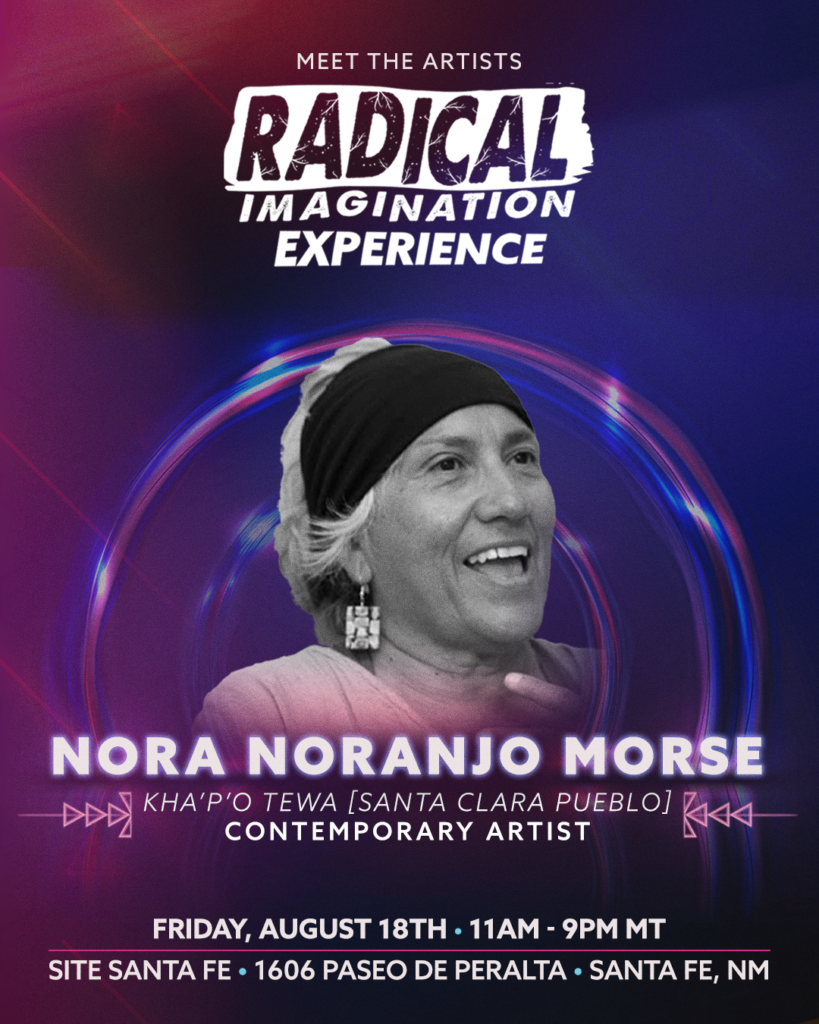
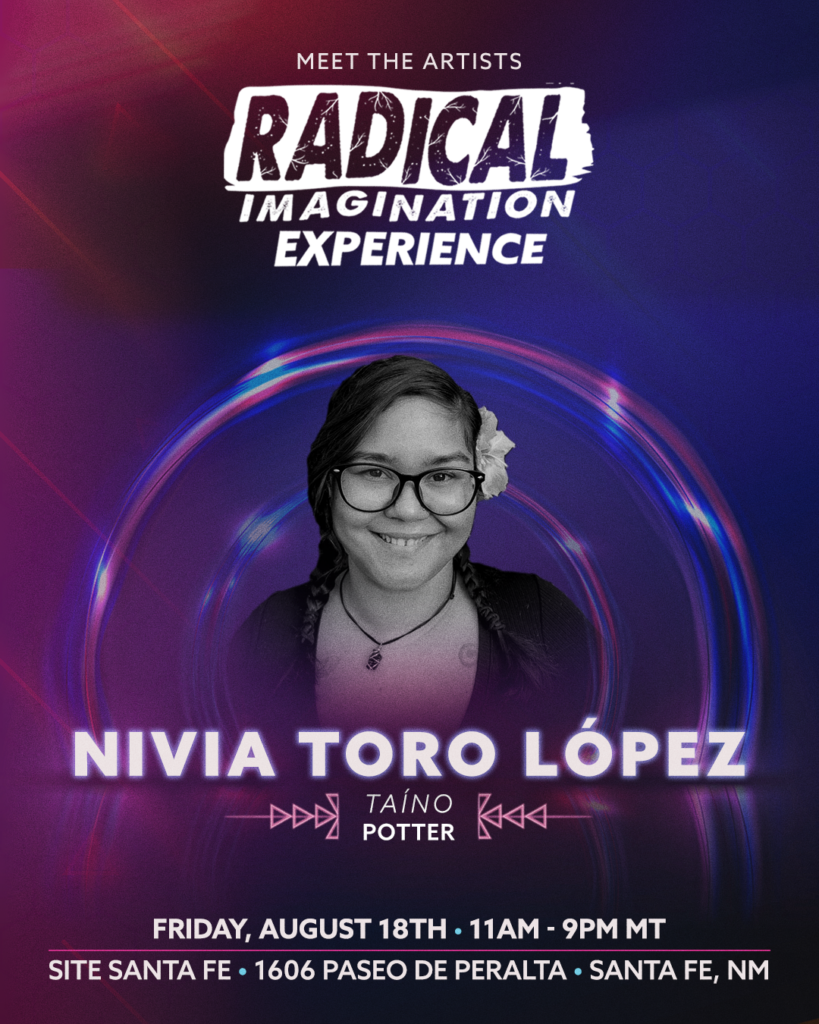
Alongside fellow artists of the 2021 Radical Imagination Artist and Storyteller Cohort, Nora and Nivia will both be joining the community of Santa Fe for a free all-day Radical Imagination Experience event taking place on Friday, August 18th from 11a.m. to 9p.m.
In our final countdown to Friday, we joined in conversation with Nora and Nivia about their radically imagined creations.
This is what they had to say:
What did the Radical Imagination grant allow for you to focus on as an artist during the year?
Nora: I think the fellowship was multipronged in that I didn’t really quite expect for it to have such a large impact in what I originally proposed in my application. I had this very vague concept of what I wanted to do with it. But then, the radical imagining set in and it became this much larger project that really gave me a look inside myself as an artist, as a woman, as a community member. It helped me to see, by placing into perspective what I wanted to do when this project was over. I think that was one of the most surprising things for me is that the whole project took me by surprise, in a very positive way.
Nivia: I was able to focus on my community, especially to be able to offer them workshops without being worried about if they can afford it or not. That was great because I have been teaching since 2011. During my Bachelor’s Degree, I got this interning opportunity and I realized that I love teaching and being able to help people learn. I started doing workshops and that’s how I applied for the grant. Having it was such a relief. I met hundreds of people and was able to impact and help them recognize the need for art, especially to connect with [the] clay of my community. Nowadays it is so popular and I want to think that I had something to do with that. I’m currently focusing on my fellow queer community and doing these weekly workshops that I call “Queering Clay.” I want to continue to focus even more on my Indigiqueers, and it’s thanks to the grant.
Every time I feel I’m on block, I also try to think a lot about my ancestors, about her, and my grandma, those very powerful women, and also my own power…I have to remember that I have power and that I have actually worked for it. It wasn’t given to me.
Nivia Toro-Lopez (Taíno)
What are the things that you learned about yourself during these times of self reflection?
Nora: Well, we were coming out of COVID and I think all of us in our community and beyond were trying to figure out what we were supposed to be doing next. A lot of our ceremonies had shut down, people were very fearful, a lot of our relatives were getting sick and so on. Before COVID, I had been really looking at how I work with recycled materials and the importance of that in our communities and how our ancestors in the Pueblos were such survivors that they were able to look around when they didn’t have the “right materials” [and] gather it from nature. Not only would they gather it from nature, with pottery or with other mediums, but they would also use discard from the larger society.
They would use that in the Depression era jewelry from around Santo Domingo, Cochiti area. I looked at that more closely during COVID because I had so much time in isolation, and that was really an inspiration for me. So, before COVID, I had been collecting materials to create these very large sculptures that were inspired by Pueblo thinking [and] were made of plastic bags, chile burlap bags, just all kinds of materials and I started repurposing them.
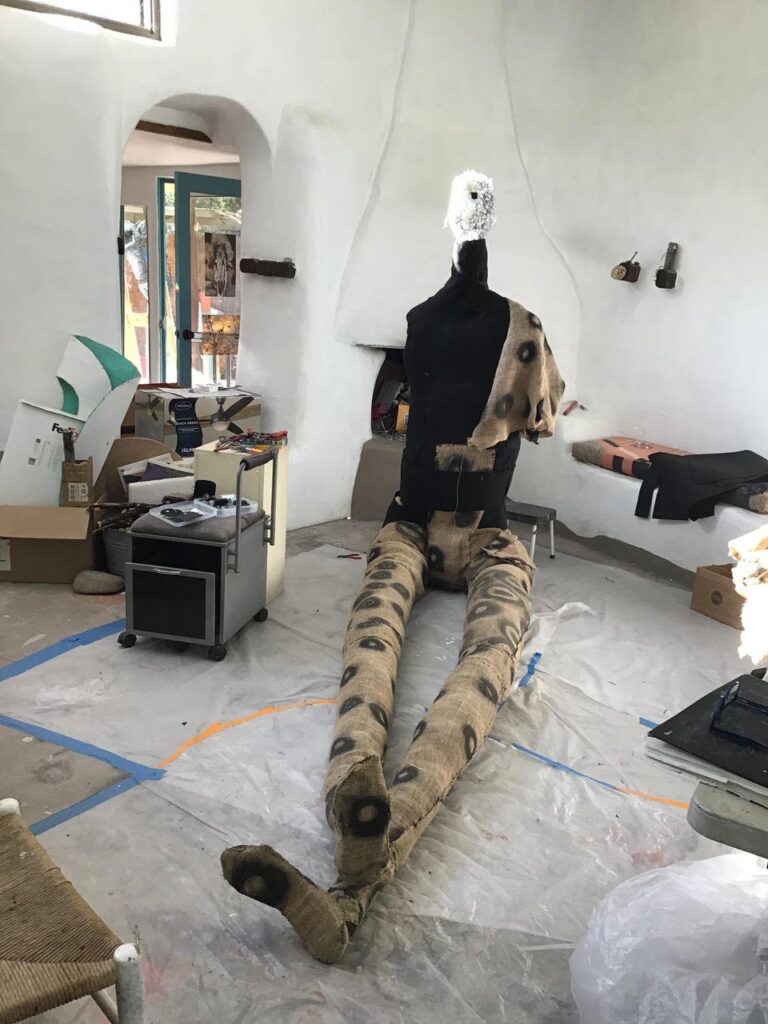
When COVID hit and we were in isolation, I had the luxury of being able to look at this new material and start reconfiguring and reworking it. The burlap was dyed and resewn together. What the fellowship gave to me was this time to explore this new direction and that was really important for me, because usually there are demand deadlines. As an artist, you’re always on this course of going to the next piece and to the next piece. I’ve been working on these pieces for five years. Radical Imagination gave me the time to do that and I will always be appreciative of that.
There are three pieces that are fairly large and they’re going to be at the SITE Santa Fe gathering. The largest one is 19 feet, another one is between 16 and 17 feet, so this is a lot of sewing, it takes a lot of time. What I did in my initial application was think about gathering help from the community and being able to share the information that I was researching. The influences from the Depression era jewelry, looking at images, and what I discovered was that the monks cloth that is used for Pueblo ceremonial dresses, the mantas, has sort of the same kind of weave as burlap; it’s very wide.
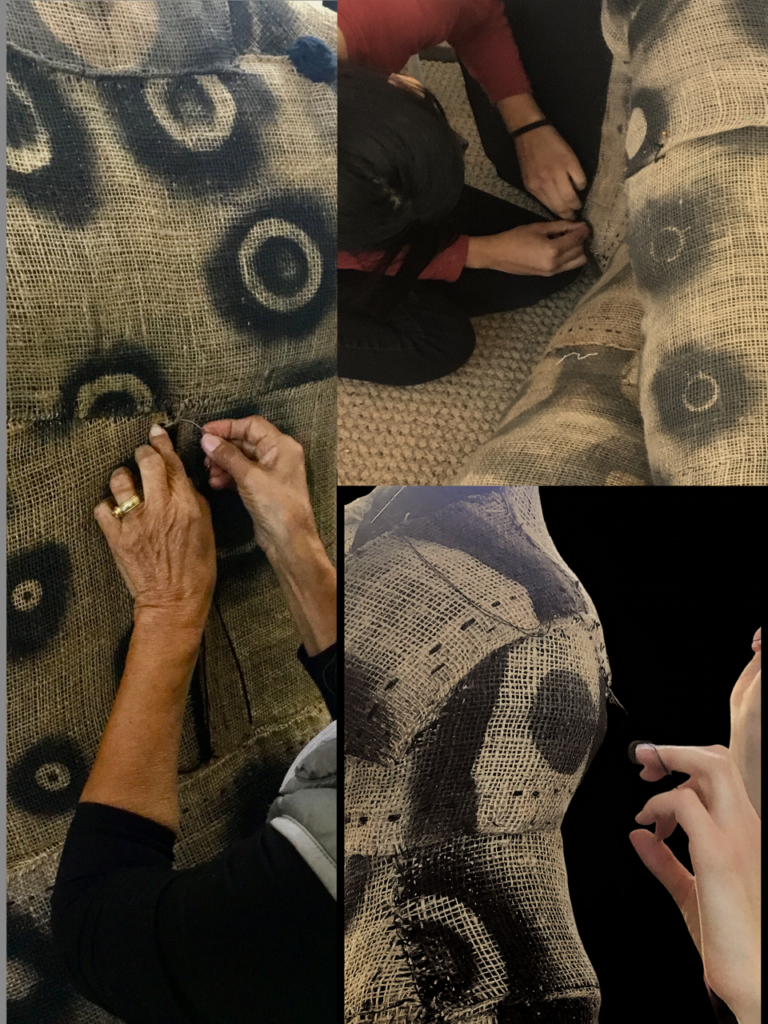
Then what I did was I asked an elder who makes mantas to show me how to sew on that kind of material. The project got even larger because we needed the help of our elders to come and show us how to sew like this, so the community of this project just kept growing as time went by. We started helping other people, other artists, who needed our help to sew. It was really humbling to see that happen because of all this radical imagining.
It started from these little seeds and it almost seemed like a perfect collection of elements, even the COVID, the forced isolation, the prior research all sort of got together and at that right moment when I got the grant. I was able to open my studio, participants were coming in, and we requested elders to help us. We started moving into other studios and other art spaces and that, to me, really defined, as I was saying earlier, what community meant for me. We’re relatives, we’re all relatives, even though we come from separate tribes and especially during these very challenging times, we need to see that and help one another.
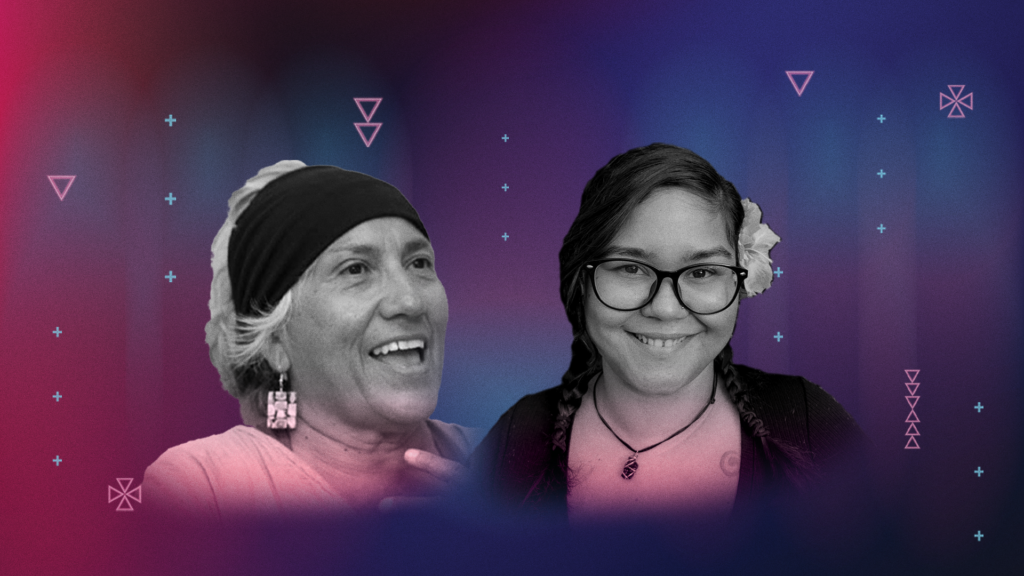
What do you look for when sparking either inspiration or motivation or even overcoming those roadblocks that you might encounter?
Nora: I’m inspired by just about everything because I live in a place that is astoundingly beautiful. The mountains, the sky, the trees, it’s all there for us. And our people knew this and they built this culture around that. I still go back to those inspirations.
You’ll see in these burlap sculptures they are called, ‘Healers from Some Other Place,’ and I was influenced by visiting my Hopi relatives during a feast. I was influenced by color or movement, just simple things like that, I soak it in and I store it in my heart so when it’s time to create, I have that well of inspiration just ready to guide and assist me. Working with recycled material has really been a new experience for me [and] I see that as an inspiration as well. I feel very grateful for just having that ability to be creatively inspired by very ordinary things or seemingly ordinary things.
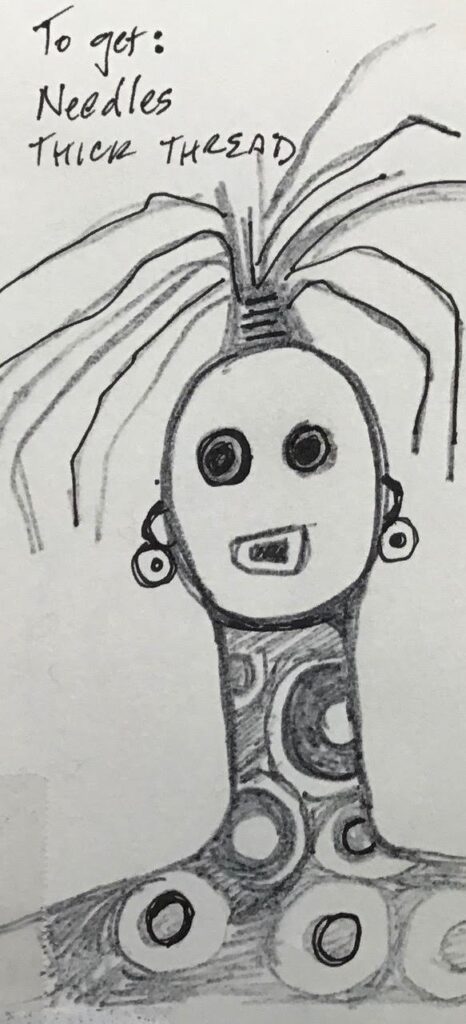
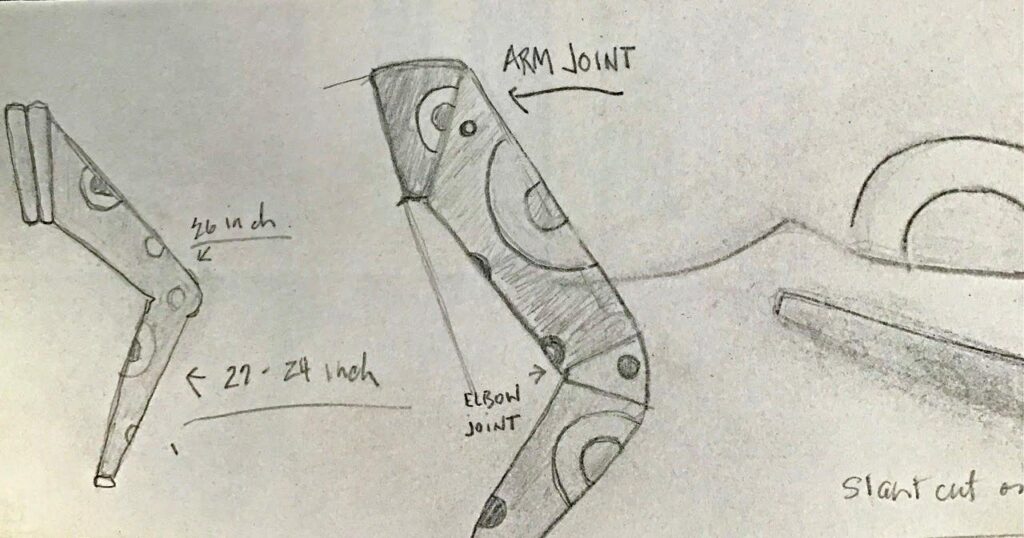
Nivia: I have an urban garden and I like to go and look at it sometimes. I like to be without shoes in my studio, which can be a little problematic sometimes because of the clay. But I like to get into my urban garden and just see how that little piece of land can create so much life and welcome so many things. I also think a lot about my mother [who] passed two years ago. She also had her birthday around this time on July 11. She died in August of 2021 and I got the grant in October of 2021, so I like to think that somehow her spirit was with me when I was applying and when I was making my intentions to have this grant. I feel like she helped me in a way.
Every time I feel like I’m on block, I also try to think a lot about my ancestors, about her, and my grandma, those very powerful women, and also my own power. I have to remember that I have power and that I have actually worked for it. It wasn’t given to me. I have worked really hard to get here. [Also] remembering that I need to rest too. Sometimes if I cannot work it’s probably because I just need to lay down and think about nothing or try to think about nothing because life is so full of many difficulties.
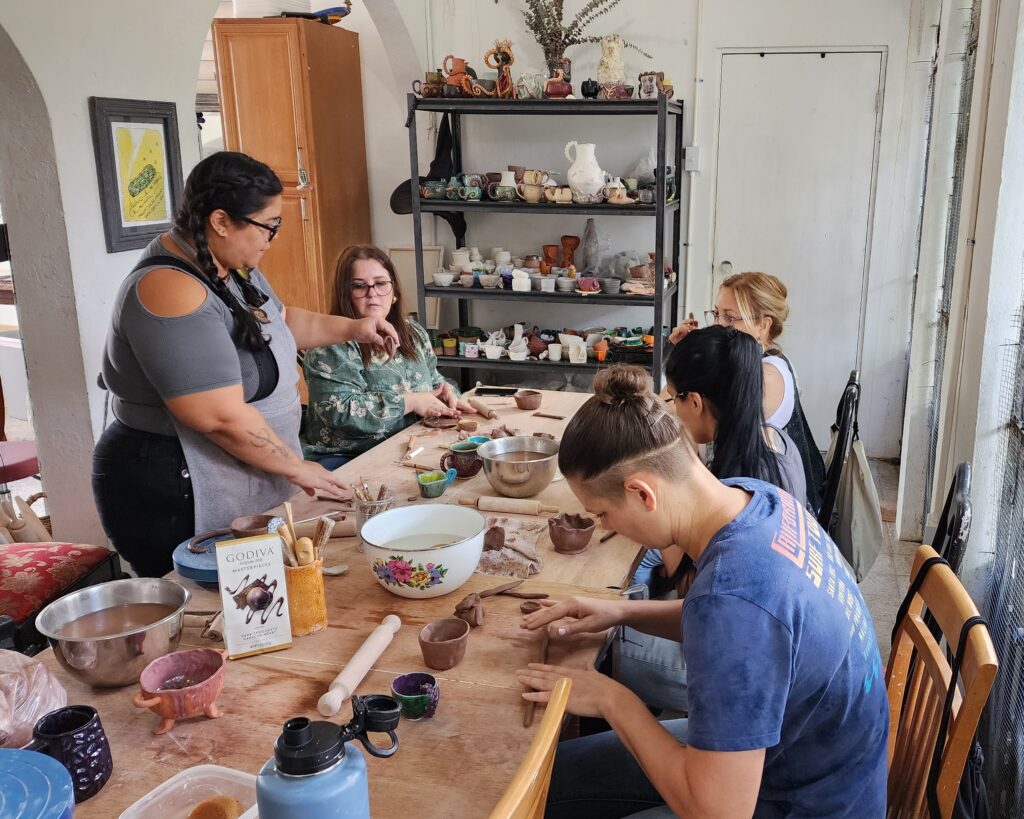
What was the most influential piece that you’ve created or worked on so far that really affected you or your community?
Nora: I’m like one of those very dedicated mothers who says, ‘Oh, I don’t have a favorite child,’ I love them all. Sincerely, every installation, sculpture, film. monotype print, whatever I’ve done I get totally immersed in it. I am, again, very grateful that I have that opportunity to work and to have the time to spend with the materials, time to think about what I’m doing, and how it relates to what’s going on in my life. Because oftentimes I speak to issues surrounding Native people, the environment, culture, family, and every piece has allowed me to think about those things.
I have a piece in Washington, D.C. that I’m going to go and check on in September and that piece was pretty pivotal for me because it allowed me to see community in the grand scale of things and community, not just with Native people, but with humanity. I did another piece in Albuquerque, New Mexico that was very controversial, and it was about colonists like Juan de Onate and I learned a lot from those pieces how to deal with people, how to deal with institutions.
I want to tell people what we’ve been talking about and how important it is to keep those connections going with our family, with our culture, and with our land.
Nora Naranjo Morse (Kha’P’o Tewa)
So, every single piece I’ve ever done has taught me something, it has given me something and expanded the world that I live in. I can’t really say that I have a favorite piece. I’m really in love with these big sculptures right now. I talk to them and I spend a lot of time with them so that they are a part of me. There’s no favorite piece. I fall in love every single time and not because they’re great pieces or that I think they’re the best pieces ever made but just that I have the ability to imagine something and set about creating them with the materials at hand. To me, that is just miraculous.
Nivia: I have many pieces that I have created that have a lot of meaning. But I think that the most meaningful right now, still in the process, [is] this lady right here. I call her Borijeva. That means she’s a Borikua, [a] really sexy creature. She is painted with native clay and is the second anatomical or figurative sculpture that I have created. To see how the native clay just wrapped around the sculpture is really interesting. I added some of the details that I like about the ocean life and then the hair [has] a little weird mohawk. It’s really hard to sculpt. It was built with sheets of clay, basically called slabs. This is one piece of work that I would like to keep on creating, but I don’t have the right kiln [for].
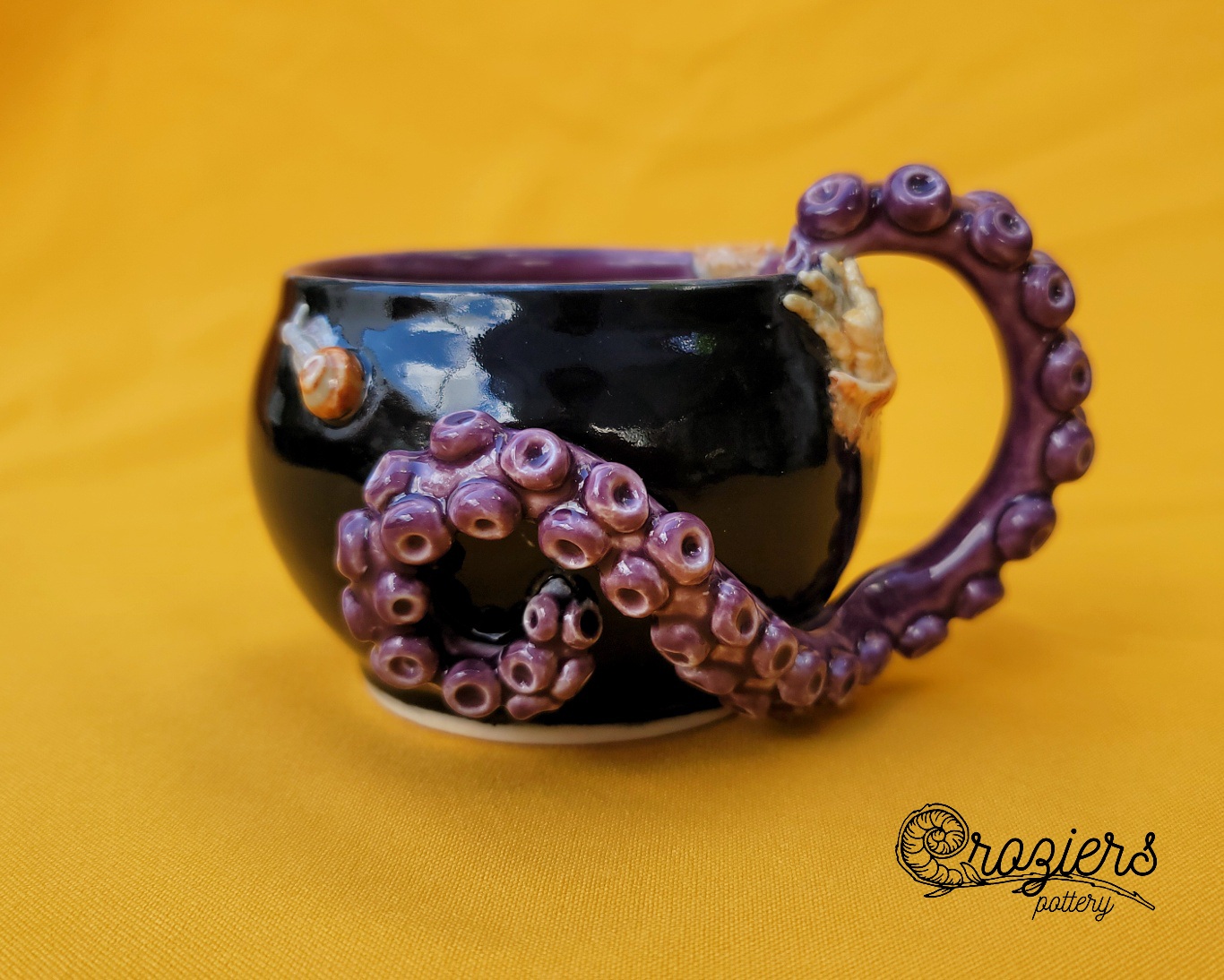
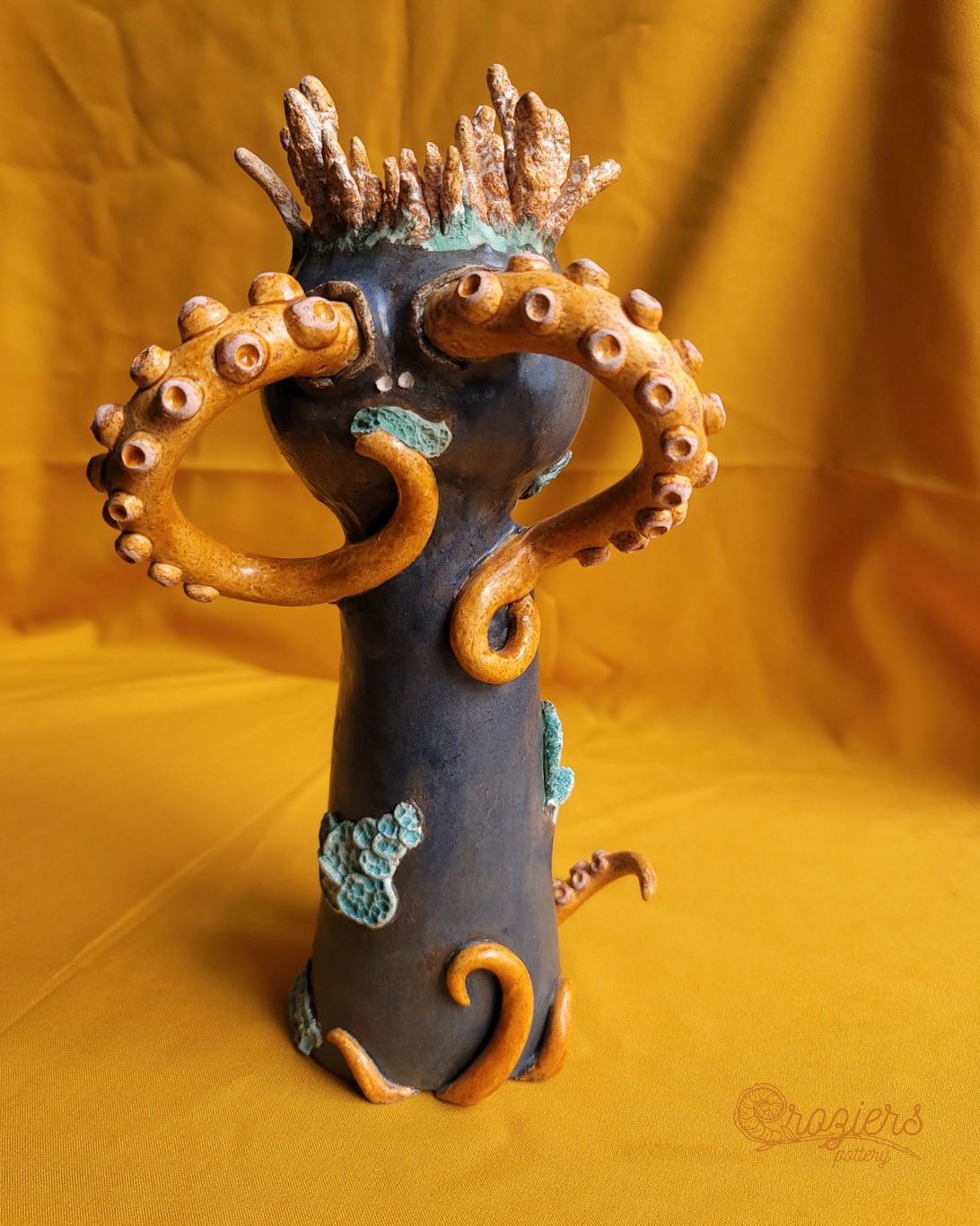

The second thing that I’m creating right now is very explicit, but this is the kind of work that I want to continue to do. She’s going to fire darker brown and with little specks, so I still don’t know how I’m going to glaze it, what colors I’m going to put on, but I definitely want to keep on exploring vessels with bulbous and intersections with ocean life and monsters. Monsters is something that really inspired me. They have always inspired me. I have a Master’s Degree and my thesis was about zombies and monsters in the Caribbean. It’s something that is always there. So I want to keep on expressing my love to the feminine or the feminized bodies or the bodies that are in-between.
For the controversial pieces or the things that people may find controversial, how were you able to overcome those hard criticisms or those individuals who may not quite get the history or the stuff that goes into your work?
Nora: Well, I’ve been making art long enough so I realized that sometimes my work is very conceptual or is not something that someone finds pleasing or has an issue with. I’m always open to listening to them and especially with that controversial piece in Albuquerque. It was officially called, ‘Cuarto Centenario.’ The piece I did for that project was called, Numbe Whageh, which means ‘Our Center Place’ and I think our center place, my own center place, is to be open to hearing other people, but being anchored enough in myself to move forward with what I think is best.
And that is a challenge, but that’s what I learned from ‘Cuarto Centenario’ and working with that very controversial issue about colonization. I think it made me stronger because it lasted for ten years before the piece was completed. There was a lot of back and forth about how you listen to people, how you think about things before you answer without reacting in a negative or hurtful way, because, really, that’s not going to get you anywhere but to be very sure about your vision. I think that’s really important to think about the vision that you have in yourself, what you’re saying, and where you want to go with that vision.
How do you look at [or view] mistakes in your work?
Nivia: If we’re talking about creating with clay. I honestly think that there are no mistakes. Clay is very forgiving. Whatever you manifest with your hands is where you’re going to manifest in. I do think that for firing, especially in an electric setting, there are mistakes that can be made. But I see them as moments to really stop and think [about] what happened there.
I don’t really get frustrated anymore with my work. Maybe at the very beginning I got frustrated because I have this hunger for knowledge. I had this desire to understand so much [that] sometimes I was getting frustrated because I knew that my mistake was because of [a] lack of understanding, lack of reading or lack of knowledge. But honestly, sometimes it just happens because we’re humans.
One time I made this handle and I forgot to do a little hole. There were five mods with the same design and one of them had a mini explosion. I’ve always known that explosions only happen because of the water content being [heated] in a really fast or dramatic way. Water has a process that, at least for the level I am in the world, is about 200° Fahrenheit. I have to get to 200° slowly. I made this mistake where this handle exploded and I realized that I was just working too fast.
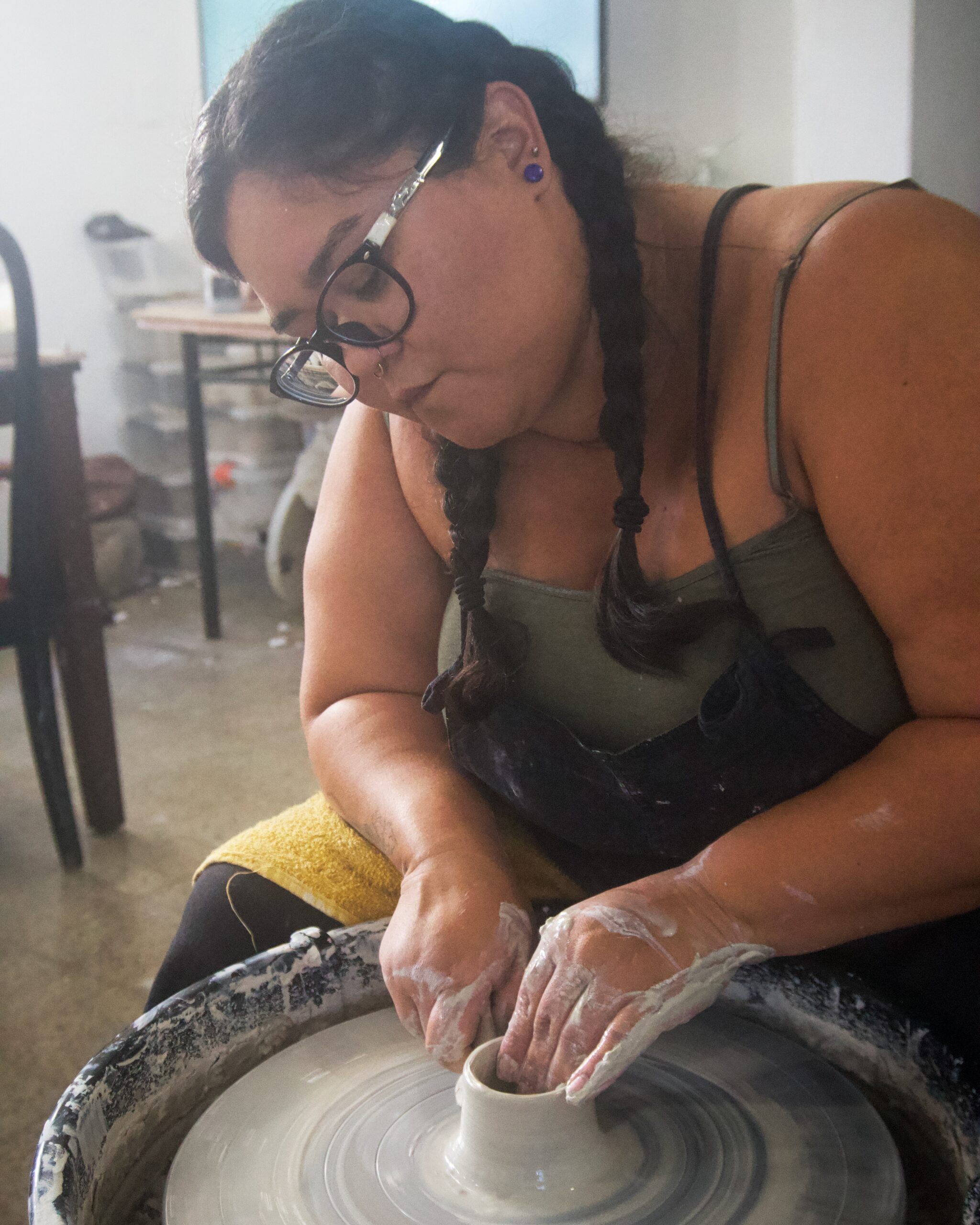
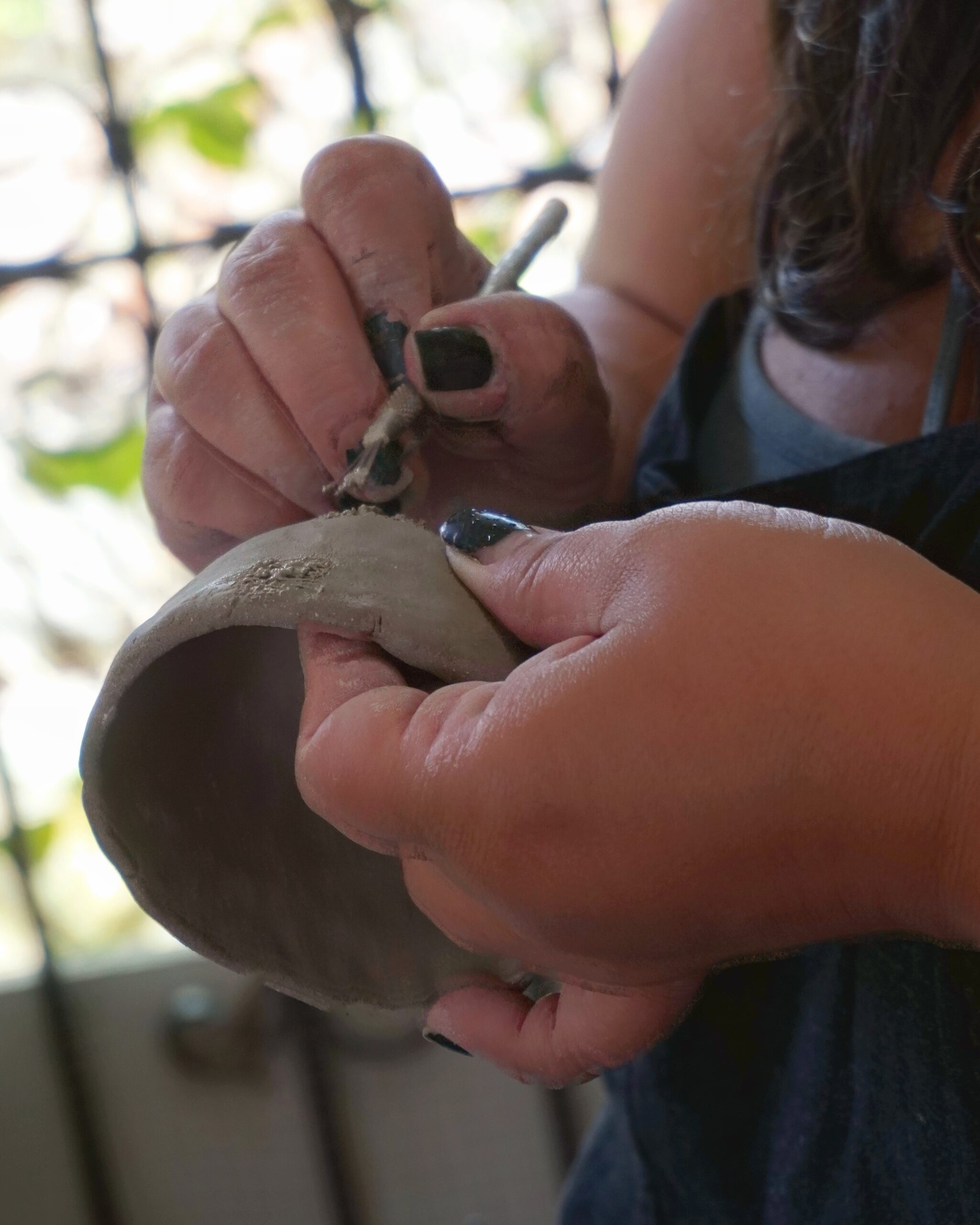
How are you preparing for the event, physically, spiritually, emotionally?
Nora: There will only be two pieces of the burlap sculptures in the show. The third one isn’t finished yet. I am returning to them again to make last minute changes, to enhance their beauty and their presence. I’ve been with them for so long that now it’s good to return to the first piece that I made and look at her with a new set of eyes [to] see what more she needs to get her ready to make her big debut. I made her some earrings out of these wire hoops I found the other day. So, I’m returning to them with a new set of eyes after working on other pieces.
I’m also taking a deep breath and thinking about what I want to say. I want to tell people what we’ve been talking about and how important it is to keep those connections going with our family, with our culture, and with our land. I want to be able to share that with people because, again, it may seem like an unimportant thing, but it’s those everyday things that culture has given us. To be able to access that clay, those materials, and use them in a way that helps us survive, that lets us have that vision to go to the next step where our people are going, wherever that direction is. We have the ancestors behind us and we’re holding on to our relatives as we move forward. That’s the kind of thing I’m thinking a lot about and that I want to share. Now the seeds have been planted and I can continue working with those elders and with those participants that were in the project.
Every single piece I’ve ever done has taught me something, it has given me something and expanded the world that I live in
Nora Naranjo Morse (Kha’P’o Tewa)
Nivia: I need to take a better look at the weather. I get a little scared when I’m traveling because of not being prepared with the correct clothing. Physically, I’m trying to keep being healthy and drinking my vitamins. I’m taking really small walks and having my vitamin D. Emotionally, I am extremely excited. I’m still thinking that this is a dream.
Spiritually, my mom is really present. I have been connecting with her and I’ve been dreaming about her, too. I’m also finishing some pieces. For me, to work with clay is also my spiritual practice. I don’t really have another way to explain it. I have been connected with my spirituality for the past maybe eight years. I think academia did its thing where I thought that spirituality was not a real thing, and then I had to reconnect and realize that I’m a highly sensitive and also very intuitive person. I hope to bring this one in its finished form.
It was such a joy and honor to sit down with both Nora and Nivia. Finding inspiration within themselves and their communities, they embody cultural knowledge and resilience–an intergenerational spirit that has been within Indigenous communities since our creation. We look forward to being in community with them at the Radical Imagination Experience in Santa Fe this Friday.
Nora and Nivia will be part of panel discussions during the Radical Imagination Experience event, alongside fellow 2021 Radical Imagination cohort members on August 18th. Nora’s will occur at 12:15pm MT and Nivia’s at 1:15pm MT. Until then, we wish both Nora and Nivia continued inspiration and innovation as they utilize both of their mediums to create brave and healing pieces.
We hope you can join us! NDN Collective will also be live streaming the event on our Facebook and YouTube pages
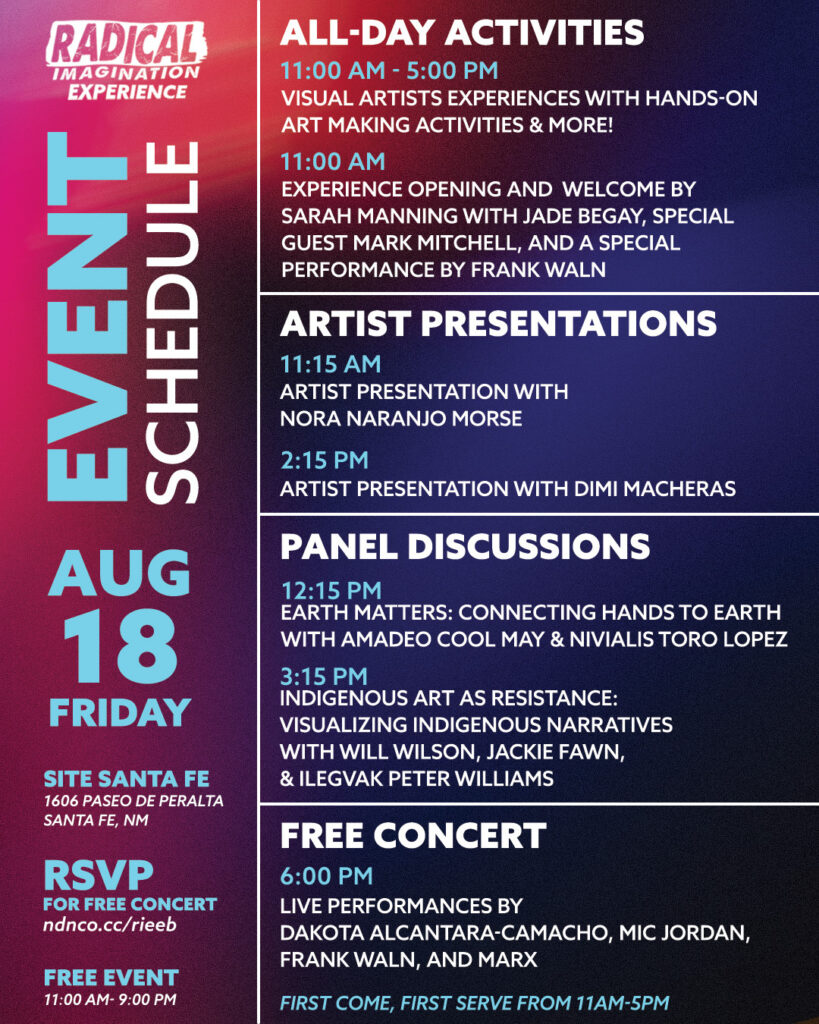
Related Articles:
Blog | ‘We Are Here!’: Indigenous Art & Expression from Opposite Ends of Turtle Island
Blog | Community, Salmon, & Water: How Indigenous Illustrator Jackie Fawn Creates Art for the Movement
Press Release | NDN Collective to Hold Free Event Focused on Resistance & Art
Blog | Announcing NDN Collective’s 2022 Radical Imagination Artist & Storyteller Cohort
Blog | NDN Collective Kicks Off Radical Imagination Virtual Festival, A Multi-Day Event
NDN Live | Radical Imagination Virtual Festival
Blog | Announcing NDN Collective’s 2021 Radical Imagination Artist & Storyteller Cohort
Blog | NDN Collective Selects Ten Indigenous Radical Imagination Artists From Across Turtle Island
